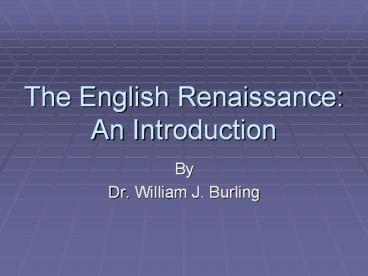The English Renaissance: An Introduction - PowerPoint PPT Presentation
1 / 46
Title:
The English Renaissance: An Introduction
Description:
Continental origins Italy, in particular. English origins ... Importance of Tottel's 'Miscellany' (1557) Henry Howard, earl of Surrey; executed age 30 ... – PowerPoint PPT presentation
Number of Views:388
Avg rating:3.0/5.0
Title: The English Renaissance: An Introduction
1
The English RenaissanceAn Introduction
- By
- Dr. William J. Burling
2
The English RenaissanceOverview
- Continental originsItaly, in particular
- English origins
- Literary developments in poetry, prose fiction,
and drama
3
Continental Origins
- Important Developments in Italy in the 13th and
14th centuries. - Fall of Constantinople in 1453
4
Key Moments of the Italian Renaissance
- Giottos paintings (late 13th, early 14th
centuries) - Importance of Florence Ghibertis Doors to the
Baptistry (1401)
5
Medieval Italian Art
Bernardo Daddi, 1335 (late example of older
Byzantine style)
6
Giotto (c. 1226-1337)
- Widely considered to be one of the first
innovators of the new modes of naturalism and
space in painting - Praised by Dante in The Divine Comedy
7
The Mourning of Christ (Giotto, c. 1305)
8
Ghibertis Doors (1401)
9
Ghiberti, detail from Doors
10
Significance of Ghibertis Doors
- Highly sophisticated emphasis on correct
perspective, realism - Church relaxes the position of contemptu mundi
- Church becomes chief patron of high renaissance
art (Michelangelo, etc.)
11
Michelangelo (1475-1564)
1508-1512
Detail, Sistine Chapel
12
Italian Literary ModelsDante (1265-1321)
Vita Nuova (by 1294) MS lyric love poems to
Beatrice The Divine Comedy (c. 1304-1317)
MS epic poem
13
Petrarch (1304-1374)
Canzoniere (MS. begun c. 1336 completed c.
1374) contains 366 poems Contains the sonnets
to Laura
14
Political Factors
- Pressure on Eastern Roman Empire from the Turks
fall of Constantinople in 1453 - Refugees emigrate to West Europe, dissemination
of learning, concentration in Italy
15
Rise of Ottoman Empire
- Earlier sieges of Constantinople 1394-1402
1422. City was a last Christian island in the
midst of the Islamic territory. - Final capture of the city in 1453 by Meh.med II
the end of the eastern Roman (Byzantine) Empire - Extensive expansion of the Ottoman Empire by
Suleiman the Magnificent (sultan, 1520-66) and
his son (1566-74). - Empire lasted until the end of WW I
16
The Ottoman Empire (c. 1683)
17
The Renaissance Comes to England
- Introduction of the Printing Press, 1476
- Political Stability under the Tudors, 1485,ff
18
New Technology The Printing Press comes to
England, 1476
19
Stability and Progress
- Henry VII defeats Richard III in 1485 to end the
War of the Roses - Establishes Tudor dynasty and stability
- Fosters artistic and economic development
20
Significant Developments in England, 1509-47
- Sends delegations to Rome
- Delegates return to England inspired by Italian
art, music, and literature - 1534 Disenfranchises the Catholic Church and
establishes the Church of England
21
Reformation . . .
Martin Luther (1483-1546) 1517 95 Theses
nailed to the door of the Castle Church at
Wittenberg
22
And Counter-Reformation
The Trial of Galileo
23
Early Renaissance Poetry
- John Skelton (Poet Laureate to Henry VIII)
example of pre-Italian style - Importance of Italian influence impact of
Petrarch and Dante - Thomas Wyatt example of Italian influence
protégé Henry Howard, earl of Surrey - Rapid development of poetic forms and techniques
- Importance of Tottels Miscellany (1557)
24
Henry Howard, earl of Surrey executed age 30
Sir Thomas Wyatt died age 39
25
Tottels Songs and Sonnets written by the Right
Honourable Lord Henry Howard Late Earl of Surrey
and Other (1557)
- First major published collection of English
poetry - Contains 271 poems
- Established the reputations of Wyatt and Howard
26
Early Renaissance Prose Fiction
- Sir Thomas More (1478 executed 1535)
- Utopia (1516)
27
Early Renaissance Drama
- Significant influence of English mystery and
morality drama - Emphasis on secular themes after 1540, especially
tragic lives of kings (e.g., Gorboduc and the
Mirror for Magistrates) - Classical influence Seneca (tragedy) Plautus
and Terence (comedy)
28
Reign of Elizabeth I (1558-1603)
- Significance of emerging English nationalism
(defeat of the Armada, 1588) - Powerful advocate and defender of Protestantism
29
Defeat of the Armada, 1588
30
High Renaissance Poetry
- High degree of sophistication and elegance
- Philip Sidney
- Edmund Spenser
- William Shakespeare
- Ben Jonson
- John Donne
- John Milton (early career)
31
Elizabethan Era Poetry
Sir Philip Sidney
Edmund Spenser
32
The Faerie Queene (1596)
33
Jacobean Poetry
John Donne
Ben Jonson
34
John Milton (1608-1674)As a young man.
35
Milton (post-1660)
36
Women Authors
Mary Sidney Herbert, Countess of Pembroke
(1562-1621) Arcadia, Psalms
Aemilia Lanyer (1569-1645) Salve Deus Rex
Judaeorum (1611)
37
High Renaissance Drama
- Establishment of first patent companies and first
permanent theatres in London - The Theatre (1576)
- The Rose (1592)
- The Swan (1596)
- The Globe (1599)
38
The Globe, 1599
39
The New Globe (interior)
40
Select Important Playwrights
- Christopher Marlowe
- William Shakespeare
- Ben Jonson
- John Fletcher
- Thomas Middleton
41
Shakespeares Contemporaries
Christopher Marlowe
John Fletcher
42
Shakespeares Contemporaries
- Thomas Middleton (1580-1627)
- A Game at Chess (1625) single most popular play
of the Renaissance era
43
1564-1616
44
War (1642-49)
- Charles I (1623-1649)
- Supported colonization
- Unpopular monarch
- Created religious strife sends groups into exile
- Isolated from the people
- Conflicts with Parliament result in Civil War and
eventual execution in 1649 - Cavalier poetry emerges
45
Cavalier Poets
Sir Richard Lovelace
Sir John Suckling
46
and Commonwealth (1649-1660)































